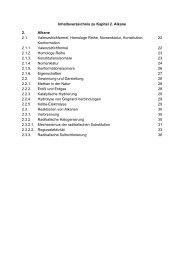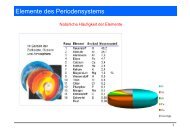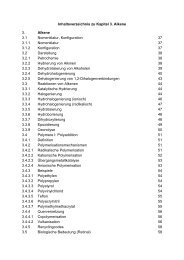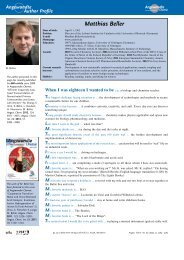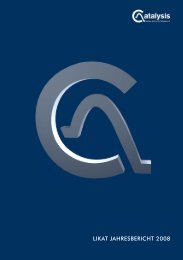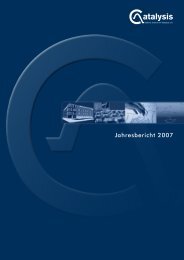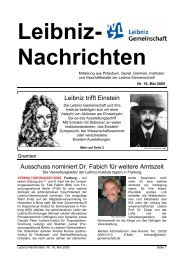An Overview of the Department's Activities - Leibniz-Institut für ...
An Overview of the Department's Activities - Leibniz-Institut für ...
An Overview of the Department's Activities - Leibniz-Institut für ...
Erfolgreiche ePaper selbst erstellen
Machen Sie aus Ihren PDF Publikationen ein blätterbares Flipbook mit unserer einzigartigen Google optimierten e-Paper Software.
98<br />
Der Forschungsbereich<br />
im Überblick<br />
Die Arbeitsgruppe Physikalische und Theoretische Chemie ist<br />
sowohl an der Universität Rostock als auch am <strong>Leibniz</strong>-<strong>Institut</strong><br />
<strong>für</strong> Katalyse aktiv. Der Forschungsbereich am <strong>Leibniz</strong>-<strong>Institut</strong><br />
konzentriert sich auf den Einsatz der Schwingungsspektroskopie<br />
in der Katalyse. Dies umfasst den Aufbau einer Hochdruck<br />
in-situ-IR-Spektroskopie, die Optimierung der experimentellen<br />
<strong>An</strong>ordnung sowie die Entwicklung und <strong>An</strong>wendung von<br />
Programmen zur Zerlegung von Spektrenreihen. Untersucht<br />
werden die Mechanismen katalytischer Reaktionen. Im Fokus<br />
stehen die Identifizierung katalytisch aktiver Spezies sowie die<br />
Bestimmung der Kinetik von Komplex- und Clusterbildung. Berechnete<br />
Schwingungsspektren unterstützen die Interpretation<br />
der gemessenen Spektren und erlauben Vorhersagen <strong>für</strong> die<br />
Empfindlichkeit der IR-Spektroskopie. Die schwingungsspektroskopischen<br />
Eigenschaften können mit Resultaten aus der NMR-<br />
Spektroskopie korreliert und so daraus Struktur-Eigenschaftsbeziehungen<br />
gewonnen werden.<br />
Weitere Forschungsaktivitäten<br />
Pr<strong>of</strong>. Dr. Ralf Ludwig<br />
Bereichsleiter<br />
Tel.: (0381) 498 – 6517<br />
Fax: (0381) 498 – 6524<br />
ralf.ludwig@uni-rostock.de<br />
Assoziierter Forschungsbereich – associated research area<br />
Schwingungsspektroskopie<br />
Vibrational Spectroscopy<br />
Darüber hinaus beschäftigt sich unsere Arbeitsgruppe „Physikalische<br />
und Theoretische Chemie“ in der Chemie mit der<br />
Untersuchung von Clustern, Flüssigkeiten und Grenzflächen.<br />
Mit einem geeigneten Methodenspektrum schlagen wir eine<br />
Brücke zwischen Experiment und Theorie. Dabei stehen der IR-,<br />
Raman- und NMR-Spektroskopie quantenchemische Rechnungen,<br />
CPMD-Simulationen und klassische Molekulardynamische<br />
Simulationen gegenüber. Dieses Methodenspektrum möchten<br />
wir peu à peu auch <strong>für</strong> das Verständnis von Prozessen in der<br />
Katalyse einsetzen.<br />
Wichtige Themengebiete sind: <strong>An</strong>omalien, Struktur und Dynamik<br />
von Wasser und wässrigen Lösungen, Eigenschaften Ionischer<br />
Flüssigkeiten, Wasserst<strong>of</strong>fbrückennetzwerke, Hydratation<br />
von Ionen, organischen und biologischen Molekülen, hydrophobe<br />
Effekte, der Einfluss von Temperatur, Druck und Additiven<br />
auf das Aggregationsverhalten organischer Moleküle und<br />
auf die Struktur von Biomolekülen. Hauptziel ist die Vorhersage<br />
makroskopischer Eigenschaften auf Grundlage molekularer<br />
Wechselwirkungen.<br />
Kooperationspartner:<br />
Pr<strong>of</strong>. Dr. Armin Börner, Dr. Detlef Selent<br />
Pr<strong>of</strong>. Dr. Matthias Beller, Dr. Hendrik Junge<br />
<strong>An</strong> <strong>Overview</strong> <strong>of</strong> <strong>the</strong><br />
Department’s <strong>Activities</strong><br />
The research group Physical and Theoretical Chemistry is active<br />
at <strong>the</strong> University <strong>of</strong> Rostock as well as at <strong>the</strong> <strong>Leibniz</strong>-<strong>Institut</strong>e<br />
for Catalysis. The research program at <strong>the</strong> <strong>Leibniz</strong>-<strong>Institut</strong>e for<br />
Catalysis is focused on establishing vibrational spectroscopy in<br />
catalysis. This includes <strong>the</strong> implementation <strong>of</strong> a high pressure<br />
in-situ infrared spectroscopy, <strong>the</strong> optimization <strong>of</strong> <strong>the</strong> experimental<br />
setup as well as <strong>the</strong> development and application <strong>of</strong> programs<br />
for decomposing series <strong>of</strong> vibrational spectra. We study<br />
<strong>the</strong> mechanism <strong>of</strong> catalytic reactions. In particular, we are interested<br />
in identifying <strong>the</strong> catalytic active species and developing<br />
<strong>the</strong> kinetics <strong>of</strong> <strong>the</strong> complex and cluster formation. Calculated<br />
vibrational spectra support <strong>the</strong> interpretation <strong>of</strong> measured spectra<br />
and allow predictions for <strong>the</strong> sensitivity <strong>of</strong> IR spectroscopy<br />
in catalytic reactions. The vibrational properties can be correlated<br />
with those from NMR spectroscopy and deliver interesting<br />
structure-property relations.<br />
Fur<strong>the</strong>r research activities<br />
Moreover <strong>the</strong> research group „Physical and Theoretical Chemistry”<br />
investigates clusters, liquids and interfaces. Using appropriate<br />
methods we combine experiment and <strong>the</strong>ory. On one<br />
hand we use IR, Raman and NMR spectroscopy, on <strong>the</strong> o<strong>the</strong>r<br />
hand we calculate properties by using density-functional calculations,<br />
classical molecular dynamics simulations as well as<br />
CPMD-simulations for small systems. Step by step we will try<br />
to make use <strong>of</strong> <strong>the</strong>se methods for understanding processes in<br />
catalysis.<br />
Important topics are: <strong>An</strong>omalies, structure and dynamics <strong>of</strong> water<br />
and aqueous solutions, properties <strong>of</strong> ionic liquids, hydrogenbonded<br />
networks, hydration <strong>of</strong> ions, organic and bio molecules,<br />
hydrophobic effects, influence <strong>of</strong> temperature, pressure and<br />
additives on <strong>the</strong> aggregation behaviour <strong>of</strong> organic molecules<br />
and on <strong>the</strong> structure <strong>of</strong> bio molecules. Our main goal is <strong>the</strong><br />
prediction <strong>of</strong> macroscopic properties on <strong>the</strong> basis <strong>of</strong> molecular<br />
interactions.<br />
99




